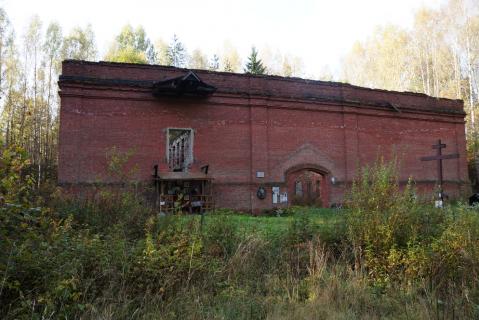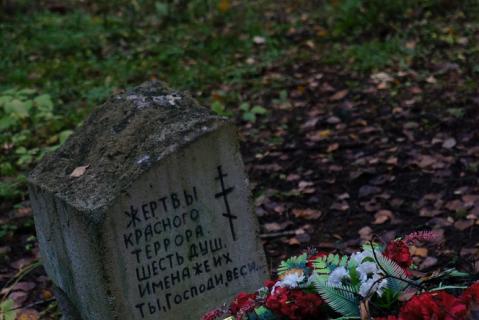The Kovalyovsky woods form part of the Rzhevsk artillery firing range. In 1918-1921 it was the site where those condemned by the Petrograd Cheka were shot. The half-destroyed powder store on this part of the range was used as a holding area for those awaiting execution; a road led there from the highway. Researchers suggest that about 5,000 people were shot and buried there, including those accused of belonging to the mythical Petrograd military detachment. It seems that shootings in the Kovalyovsky woods came to an end in winter 1921/1922 after it became known where the executions were taking place.
For many years the Memorial Research and Information Centre headed by Veniamin Joffe searched for the sites used for execution during the Red Terror. In summer 2001 the Memorial exploration group found a pit in the area containing the remains of six people who had been shot. Ballistic examination showed that the shots were fired from the Japanese Arisaka rifle that the Cheka began to use in 1918. Memorial organised the clearing of the road to the powder store and the site of the executions. On 25 August 2001 Memorial put up several memorials: a plaque on the wall of the powder store cellar “To the victims of the Red Terror”, a marker on the site where the remains were exhumed and reburied, and a stone to mark the possible location of Nikolai Gumilyov’s burial. From the mid-2000s the Orthodox brotherhood of St Anastasia of Sirmium began to care for the site. In Spring 2007 an Orthodox cross was erected and consecrated next to the powder store and in 2009 a cross was placed where the road leads from the Ryabov Highway to the burials of the executed.
The Kovalyovsky Woods are regularly visited by excursions and in 2009-2010 the Memorial RIC (St Petersburg) developed the concept of a Park of Remembrance at the site including a museum and memorial complex. (For later executions on another part of the firing range, see Koirankangas [47-02].)
No Book of Remembrance has been published for the Leningrad Region. Information about those shot in the late 1930s is included in the 19-volume Leningrad Martyrology : accounts of earlier executions may be found in the literature cited below.
The Memorial database (2025) lists 47,550 victims in the Leningrad Region.
46,382 were shot, almost all during the Great Terror (46,257). This includes most of those first sent to the camps or deported to special settlements: 1,823 who had earlier been sentenced to 5-10 years in the camps (2,087) and 998 previously deported from the Region with their families (1,071).
| Date | Nature of ceremonies | Organiser or responsible person | Participants | Frequency |
|---|---|---|---|---|
|
25 August
|
Secular service marking the Day in Commemoration of the Victims of the Red Terror
|
the Anna Akhmatova Museum on Fontanka, Petersburg
|
Museum staff, visitors, schoolchildren
|
Annual event
|
|
5 September
|
Solemn events marking Remembrance Day for the Victims of the Red Terror
|
St Petersburg Memorial Society
|
members of Memorial, descendants of the victims, schoolchildren
|
From time to time
|
|
30 October
|
Remembrance Day for the Victims of Political Repression
|
St Petersburg Memorial Society
|
members of Memorial, descendants of the victims
|
Annual event
|
| State of burials | Area | Boundaries |
|---|---|---|
|
Subsidence over burial pits
|
not determined
|
not delineated
|
Materials of the Memorial Research & Information Centre archive (St Petersburg)
S.P. Melgunov, Red Terror in Russia, Berlin, 1924
V. Joffe, “First Blood, Petrograd 1918-1921”, in his New Studies in Optimism, St Petersburg, 1998
Irina Verblovskaya, “The Rzhevsk firing range – a terrible memory of the 20th century”, Grad Petrov, St Petersburg diocesе radio station [retrieved, 28 May 2022]
*
“The site of executions and burials at the Rzhevsk firing range (Kovalyovsky woods)”, Virtual Museum of the Gulag [retrieved, 28 May 2022; no longer accessible]



